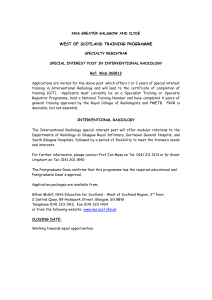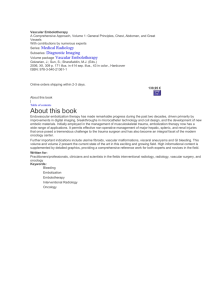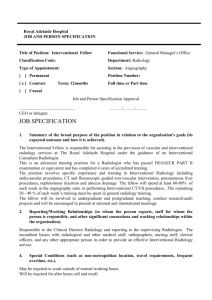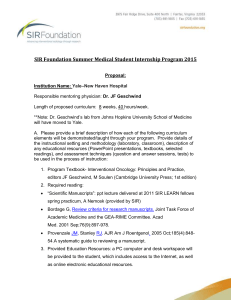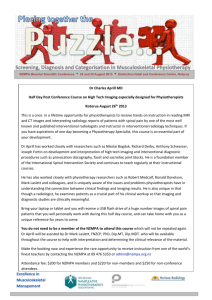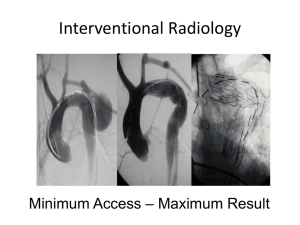John A. Kaufman Named 2012 Dotter Lecturer by Society of
advertisement
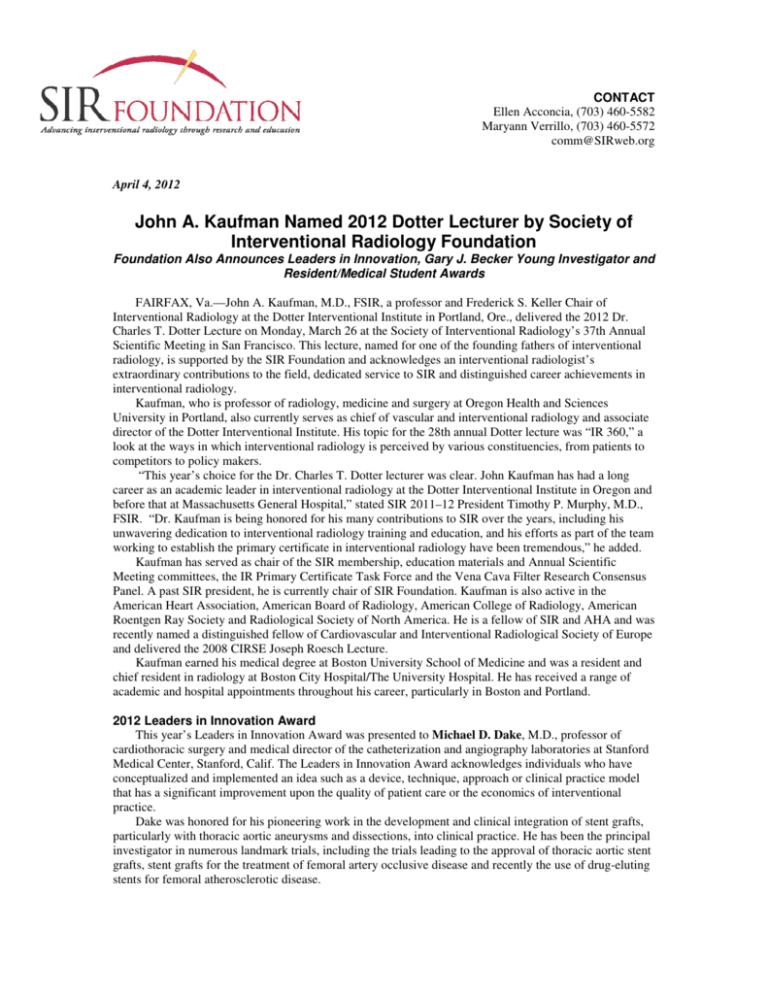
CONTACT Ellen Acconcia, (703) 460-5582 Maryann Verrillo, (703) 460-5572 comm@SIRweb.org April 4, 2012 John A. Kaufman Named 2012 Dotter Lecturer by Society of Interventional Radiology Foundation Foundation Also Announces Leaders in Innovation, Gary J. Becker Young Investigator and Resident/Medical Student Awards FAIRFAX, Va.—John A. Kaufman, M.D., FSIR, a professor and Frederick S. Keller Chair of Interventional Radiology at the Dotter Interventional Institute in Portland, Ore., delivered the 2012 Dr. Charles T. Dotter Lecture on Monday, March 26 at the Society of Interventional Radiology’s 37th Annual Scientific Meeting in San Francisco. This lecture, named for one of the founding fathers of interventional radiology, is supported by the SIR Foundation and acknowledges an interventional radiologist’s extraordinary contributions to the field, dedicated service to SIR and distinguished career achievements in interventional radiology. Kaufman, who is professor of radiology, medicine and surgery at Oregon Health and Sciences University in Portland, also currently serves as chief of vascular and interventional radiology and associate director of the Dotter Interventional Institute. His topic for the 28th annual Dotter lecture was “IR 360,” a look at the ways in which interventional radiology is perceived by various constituencies, from patients to competitors to policy makers. “This year’s choice for the Dr. Charles T. Dotter lecturer was clear. John Kaufman has had a long career as an academic leader in interventional radiology at the Dotter Interventional Institute in Oregon and before that at Massachusetts General Hospital,” stated SIR 2011–12 President Timothy P. Murphy, M.D., FSIR. “Dr. Kaufman is being honored for his many contributions to SIR over the years, including his unwavering dedication to interventional radiology training and education, and his efforts as part of the team working to establish the primary certificate in interventional radiology have been tremendous,” he added. Kaufman has served as chair of the SIR membership, education materials and Annual Scientific Meeting committees, the IR Primary Certificate Task Force and the Vena Cava Filter Research Consensus Panel. A past SIR president, he is currently chair of SIR Foundation. Kaufman is also active in the American Heart Association, American Board of Radiology, American College of Radiology, American Roentgen Ray Society and Radiological Society of North America. He is a fellow of SIR and AHA and was recently named a distinguished fellow of Cardiovascular and Interventional Radiological Society of Europe and delivered the 2008 CIRSE Joseph Roesch Lecture. Kaufman earned his medical degree at Boston University School of Medicine and was a resident and chief resident in radiology at Boston City Hospital/The University Hospital. He has received a range of academic and hospital appointments throughout his career, particularly in Boston and Portland. 2012 Leaders in Innovation Award This year’s Leaders in Innovation Award was presented to Michael D. Dake, M.D., professor of cardiothoracic surgery and medical director of the catheterization and angiography laboratories at Stanford Medical Center, Stanford, Calif. The Leaders in Innovation Award acknowledges individuals who have conceptualized and implemented an idea such as a device, technique, approach or clinical practice model that has a significant improvement upon the quality of patient care or the economics of interventional practice. Dake was honored for his pioneering work in the development and clinical integration of stent grafts, particularly with thoracic aortic aneurysms and dissections, into clinical practice. He has been the principal investigator in numerous landmark trials, including the trials leading to the approval of thoracic aortic stent grafts, stent grafts for the treatment of femoral artery occlusive disease and recently the use of drug-eluting stents for femoral atherosclerotic disease. He has served in numerous SIR leadership positions, including as a member of the ethics, technology assessment and biliary reporting committees and as chair of the society’s technology assessment subcommittee for the study of endovascular grafting. Dake received his undergraduate degree from Harvard College and graduated from the Baylor College of Medicine in Houston, where he completed an internship and was a resident and chief resident in internal medicine. He received his fellowship training in pulmonary disease and completed his residency and chief residency in radiology at the University of California San Francisco where he subsequently underwent fellowship training in interventional radiology. Gary J. Becker Young Investigator Award SIR Foundation presented Edward W. Lee, M.D., Ph.D., MSc, an assistant professor-in-residence of radiology at UCLA Medical Center and David Geffen School of Medicine at UCLA in Los Angeles, with the Gary J. Becker Young Investigator Award. This recognition is given to promising young practitioners of interventional medicine early in their careers to encourage their pursuit of academic careers. SIR Foundation noted that Lee’s article, “Electron Microscopic Demonstration and Evaluation of Irreversible Electroporation-induced Nanopores on Hepatocyte Membranes,” best exemplified the promotion of academic research among young interventional radiologists. Lee obtained his bachelor’s degree from the University of California, Irvine. He earned his master’s degree in physiology and biophysics from Georgetown University, Washington, D.C., where he also earned his medical degree and doctorate in physiology/tumor biology. He completed his diagnostic radiology residency and interventional radiology fellowship training and obtained additional abdominal/thoracic imaging fellowship training at UCLA Medical Center. He has received an SIR Foundation Pilot Research Grant, Resident/Fellow Research Award and SIR Annual Scientific Meeting Poster Award in 2009, as well as awards from Cardiovascular and Interventional Radiological Society of Europe and Radiological Society of North America. Resident/Fellow Research Awards The 2012 Resident/Fellow Research Awards recognize high-quality research by trainees and provide radiology residents and interventional radiology fellows an opportunity to attend and present their scientific research at SIR’s Annual Scientific Meeting. The SIR Foundation’s 2012 research awards were presented to Khairuddin Memon, Northwestern University Feinberg School of Medicine, Chicago, Ill., “Comparative Study of Eight Staging Systems for Hepatocellular Carcinoma in 428 Patients Treated With Yttrium-90 Radioembolization”; Samdeep Mouli, Northwestern Memorial Hospital, Chicago, Ill., “High-resolution Quantitative MRI-guided Nanoembolization Enhances Drug Delivery to Liver Tumors”; and Ben Paxton, Duke University Medical Center, Durham, N.C., “Bariatric Gastric Artery Embolization for Modulation of Systemic Ghrelin Levels in a Porcine Model: Endoscopic and Histopathologic Correlation.” Constantin Cope Medical Student Research Award Six medical students received the Constantin Cope Medical Student Research Award, which recognizes high-quality research presented at the SIR Annual Scientific Meeting by medical students. This year’s award recipients are Anthony Edwards, University of Colorado School of Medicine, Aurora, Colo., “Transarterial Therapies for Unresectable Cholangiocarcinoma—a Meta-analysis” Ali Faramarzalian, Case Western Reserve University School of Medicine, Cleveland, Ohio, “Early Apoptosis and Tumor Response in N1-S1 Rodent Hepatomas to Arterial Versus Intravenous Benzamide Riboside With Monitoring by Water Apparent Diffusion Coefficient and 23Na MRI” Taoreed Lawal, Emory University School of Medicine, Atlanta, “Novel Iron Oxide Nanoparticlemediated Transcathether Intra-arterial Delivery of Doxorubicin to Liver Tumors in the VX-2 Rabbit Model: A Dose-escalation Study” Joseph McDevitt, Northwestern University, Feinberg School of Medicine, Chicago, Ill., “MRI Enables Measurement of Therapeutic Nanoparticle Uptake in Rat N1S1 Liver Tumors During Nanoablation” Scott Thompson, Mayo Clinic, Rochester, Minn., “Differential Effect of Therapeutic Hyperthermia on Cellular Viability, Death and Survival in an in vitro Model of Hepatocellular Carcinoma” Gary Tse, Georgetown University School of Medicine, Washington, D.C., “Early Changes in Plasma Angiogenic Factor Levels Following DEB-TACE” Frederick S. Keller, M.D., Philanthropist of the Year Award Eamonn P. Hobbs, FSIR, is the recipient of the 2012 Frederick S. Keller Philanthropist of the Year Award. Currently the president and CEO of Delcath Systems, Hobbs co-founded AngioDynamics and his involvement with interventional radiology and his contributions to the field span more than three decades. SIR Foundation bestowed the award in particular recognition of Hobbs’ personal contribution, his philanthropic efforts on behalf of the Foundation, and the generous donation of his time and expertise on the SIR Foundation Board over a span of six years. For more information about these awards or to learn more about the Society of Interventional Radiology Foundation, visit online at www.SIRFoundation.org. ### About the Society of Interventional Radiology Foundation SIR Foundation is a scientific foundation dedicated to fostering research and education in interventional radiology for the purposes of advancing scientific knowledge, increasing the number of skilled investigators in interventional radiology and developing innovative therapies that lead to improved patient care and quality of life. Visit www.SIRFoundation.org. About the Society of Interventional Radiology Interventional radiologists are physicians who specialize in minimally invasive, targeted treatments. They offer the most in-depth knowledge of the least invasive treatments available coupled with diagnostic and clinical experience across all specialties. They use X-ray, MRI and other imaging to advance a catheter in the body, such as in an artery, to treat at the source of the disease internally. As the inventors of angioplasty and the catheter-delivered stent, which were first used in the legs to treat peripheral arterial disease, interventional radiologists pioneered minimally invasive modern medicine. Today, interventional oncology is a growing specialty area of interventional radiology. Interventional radiologists can deliver treatments for cancer directly to the tumor without significant side effects or damage to nearby normal tissue. Many conditions that once required surgery can be treated less invasively by interventional radiologists. Interventional radiology treatments offer less risk, less pain and less recovery time compared to open surgery. Visit www.SIRweb.org. Local interviews are available by contacting SIR’s communications department staff: Ellen Acconcia, SIR communications manager/practice areas, eacconcia@SIRweb.org, (703) 460-5582, or Maryann Verrillo, SIR director of communications and public relations, mverrillo@SIRweb.org, (703) 460-5572.
